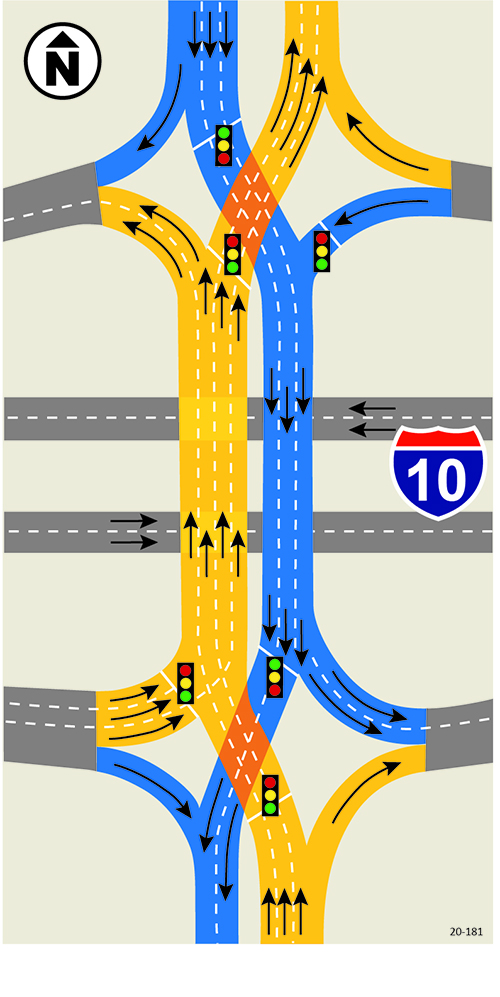Intersections are one of the most dangerous areas for any driver. Four-way intersections, T Junction, Y intersections, forks in the road, controlled uncontrolled, and don’t forget roundabouts. However, Arizona has a new intersection at highway entrances and exits called diverging diamond lanes. They came from France where the first one was built in the community of Versailles in the 1970’s. And now there are here.I-17 and Happy Valley Road, I-10 and Watson Road, I-10 at Houghton Road, The South Mountain 202 at 17th Avenue and Desert Foothills Parkway
A diverging diamond interchange is a type of diamond interchange in which the two directions of traffic on the “non-freeway” road cross to the opposite side on both sides of the bridge at the freeway. It is unusual in that traffic on the freeway overpass (or underpass) is required to briefly drive on the opposite side of the road from what is customary. The diverging diamond interchange allows for two-phase operation at all signalized intersections within the interchange. This is a significant improvement in safety since left turns need not clear oncoming traffic.
Here is an overhead view of what these look like:

One oft-quoted statistic is that over 80% of all city collisions involving injury or death occur within signal-light (or “controlled”) intersections. Adding to the severity of intersection collisions is the average speed through a city intersection is often above 50 mph, and the typical collision is usually a “t-bone,” where you are hit on your vulnerable side door.
Here’s how to lessen your risks. First, as you approach an intersection on a green light, slow down before entering it and make sure to look left-right-left; look left first, look left twice, because the first danger to you is the traffic approaching from your left. If the intersection is a “blind” one – where you can’t see the traffic on the cross street until they (or you) are so close as to be an immediate hazard, slow down even more. Do not enter an intersection you have not visually cleared. Some drivers “cover” the brake by moving their foot for a few seconds from the accelerator to a position just above the brake pedal, which helps eliminate the reaction time needed to begin braking.
The majority of collisions at controlled intersections happen within 4 seconds of a light change. You don’t want to be in the intersection during that 4 seconds. However, if you don’t immediately go when the light turns green, people behind you get irritable, yes? Try this… The first thing is make sure you stopped in the right spot. Stop far enough behind the stop line that you can see it on the pavement in front of your car – this normally gives you 10-15 feet of space. When the light turns green, take your foot off the brake and let your vehicle start to creep toward the crosswalk (easy to do with an automatic transmission).
Look left-right-left, making sure no one is running the red light and the roadway is clear of pedestrians. By this time, you are in the middle of the crosswalk (if it was clear), or close to the intersection boundary and at least a couple of seconds have elapsed. If the intersection is clear, begin to accelerate. The person behind you knew you saw the light change to green because you started to roll, so they don’t usually honk, and you stayed out of the kill zone long enough to make sure it’s safe to go.
There are two major reasons not to crowd the stop line (or the car in front of you) when stopping for a red light. First, as noted in the last section, it puts you in the right position to momentarily delay your entrance to the intersection when you get the green light. Second, even if you are not the first vehicle in line at the light, leave the same space in front—stop where you can see the rear tires of the next vehicle where they touch the road. If that vehicle stalls, you’ll have room to pull out and around it. This also gives you added room in case a vehicle behind doesn’t stop in time. If you are watchful, sometimes that few feet is enough for you to pull forward to avoid being rear-ended.
When making a left turn, don’t turn your wheels in the direction you are turning until it is clear to go. If you are rear-ended while you are waiting, your already-turned wheels may cause your vehicle to veer into the oncoming traffic and a dangerous collision.
When you are waiting to make a left turn, your view of oncoming traffic can be restricted. The temptation can be great to go anyway – even though you may not be able to see all the oncoming traffic lanes. Don’t do it, ever! It is never safe to make a blind left turn! Finally, if the left-turn lane is crowded, and it looks like it will take more than one light cycle to be able to make a left turn, consider continuing through and make three right turns instead. If you do this on city streets (not private property) it’s legal and often quicker when traffic is congested.
Keep the shiny side up!
